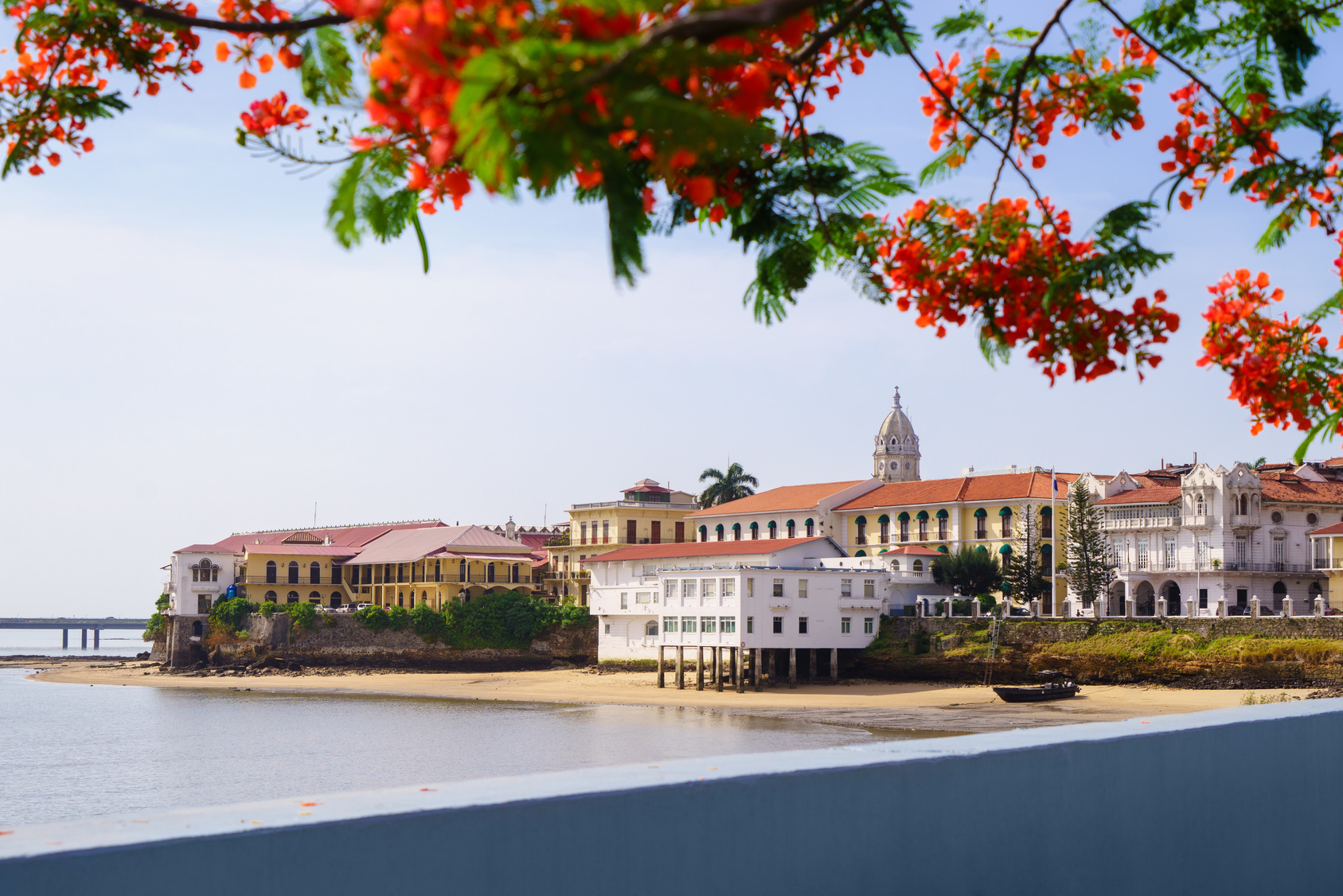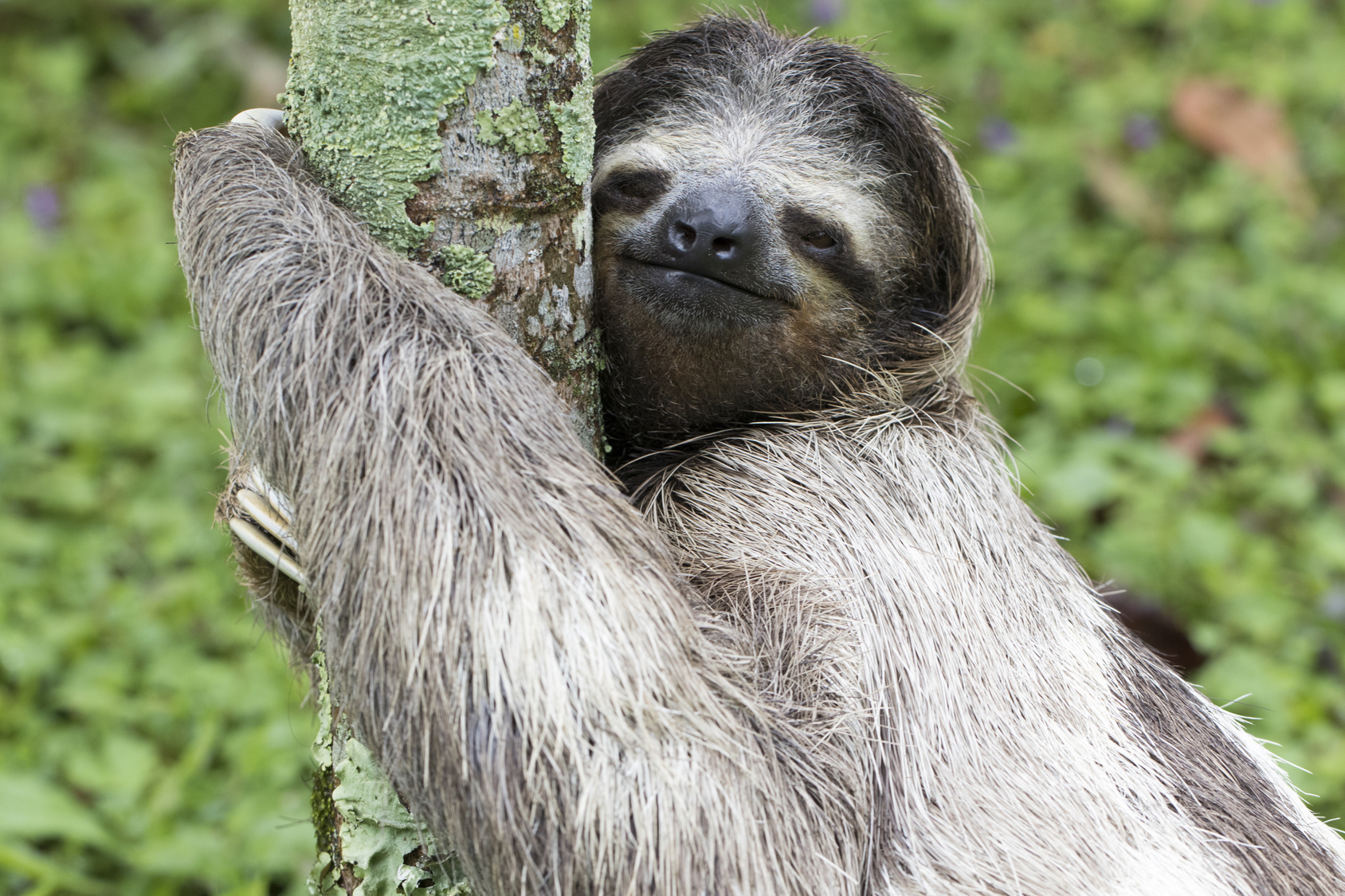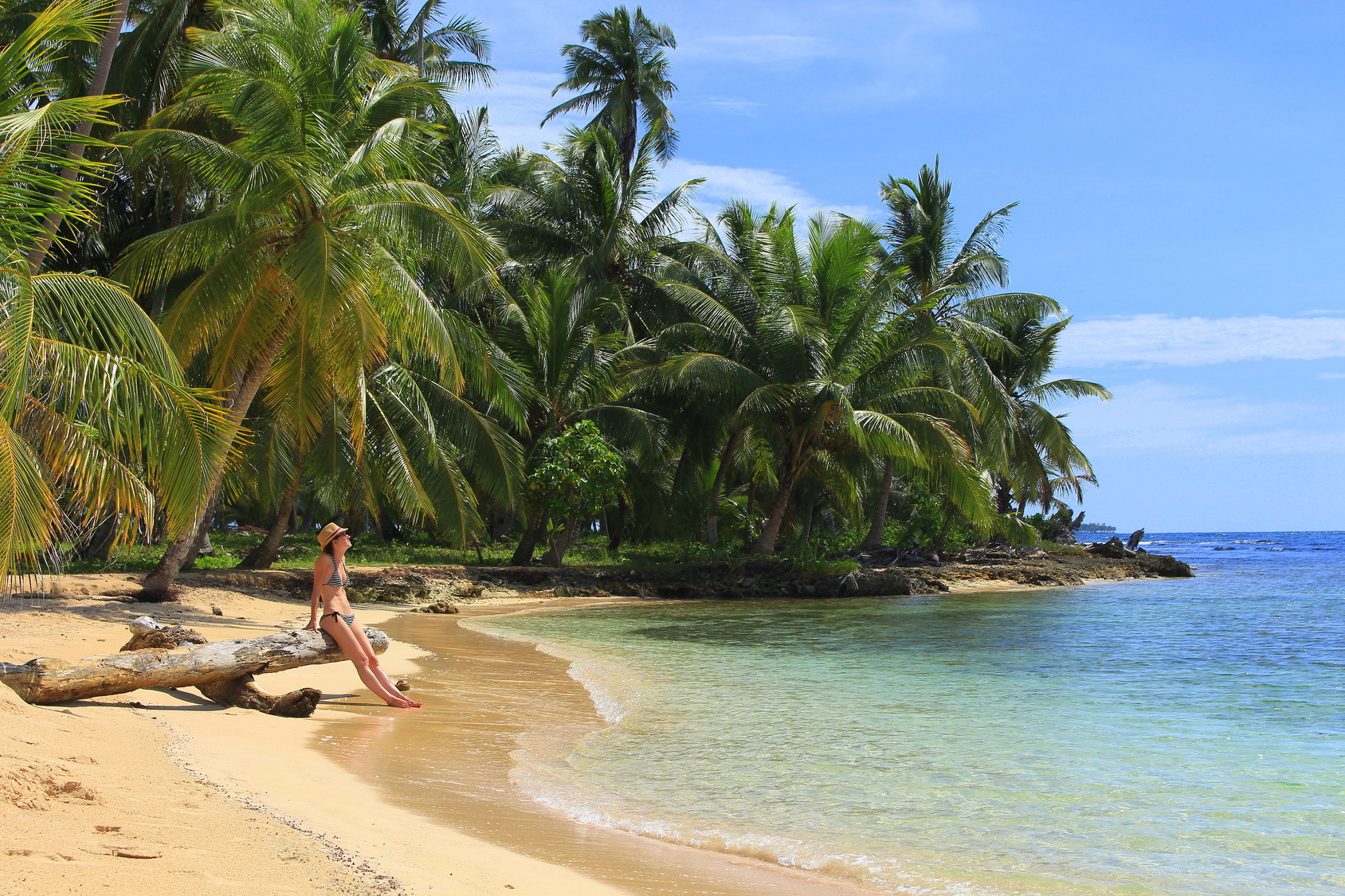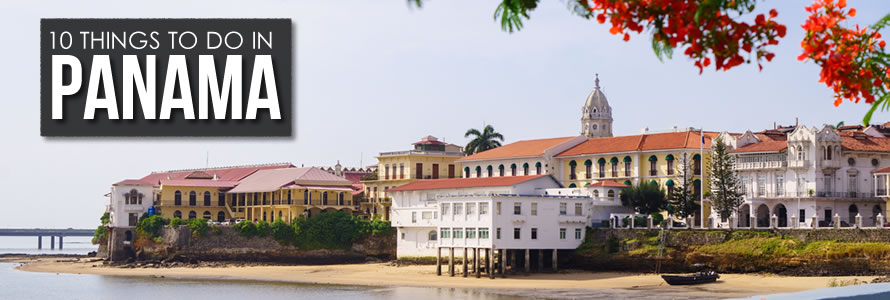Of course there is the famous canal but Panama – Central America’s southernmost country – has rather more than that to offer its visitors; from the heights of 21st century living in the country’s capital, Panama City, to stepping back in time and into scenes normally only seen in castaway movies in the San Bas Islands or stunning Bocas Del Toro.
If jungle adventures are your thing Panama can offer you that and there are heaps of adrenalin activities for the thrill seeker. Have you ever wanted to shoot the rushing rapids on a white water rafting trip, ride the waves on a surfboard or strap on an oxygen tank to explore coral reefs and underwater wonder worlds? If so all of that is here. Or if you prefer to get up close and personal with the local fauna there is plenty in that category as well with monkeys, sloths, dolphins, jaguars and an incredible variety of exotic birds to meet – to name just a few of the nation’s resident wildlife species. Party animals can get their fill, history buffs are well-catered for and for all those simply intent on lazing on a tropical beach with waving palms you are going to be spoiled for choice.
Panama has a little of everything. Here is a selection of ten of its best experiences, sights to see and possible adventures.
1) Panama Canal
Of course there is more to Panama than its world-famous canal but coming here without visiting it is unthinkable. For more than a century this iconic waterway has allowed the movement of ocean-going craft to travel between the Atlantic and Pacific Oceans without having to take on the danger-fraught passage around the tip of South America instead. Once (and still) hailed as an astounding feat of engineering, if you are stopping by try and time it so you can watch something big passing through to get the full spectacle.
Otherwise you can take a trip along the canal. There are plenty of trips and tours up for grabs which offer watercraft from tiny to luxurious or fun stuff like amphibious buses. If you don’t fancy an organised tour pick from one of the docks and make your own way. You can opt to cover just a short section or go the whole length of the canal.
Even if you’re not a water-lover you can still have a Panama Canal experience. The Panama Canal Railroad runs adjacent to the canal for long stretches or weaves its way through tropical rainforest.
2) Isla La Iguana
Named for the plentiful iguanas which sun themselves on the beaches here, Isla Iguana is a protected wildlife refuge and favourite beach escape for Panama’s visitors and its locals. With its white beaches, crystal waters and more coral reef than anywhere else in the Gulf of Panama, Isla Iguana is a magnet for divers, snorkelers, water-sport enthusiasts and all those looking for some beach lazing time surrounded by the naturally wonderful.
Eco-tourism is a big thing here as all kinds of species besides iguanas for which the island is named call Isla Iguana home or pass through at some point. The coral reefs are alive with colourful marine life as well as turtles while July to October sees migrating humpback whales with their new babies.
Head inland to the hiking trails for encounters with masses of land crabs or go adventuring in the mangrove forests. As an important nesting site for several bird species, any approach to the island tends to dish up the spectacle of large displays of flocking birds. One of the most impressive of these is the magnificent frigate – a bird which looks half pterodactyl in flight. Also common are ospreys, pelicans and plenty more.
3) Panama City
When you’re talking bang-up-to-date and modern nothing else in the whole of Central America can claim to be as much so as Panama City – the nation’s capital. Having earned itself the nickname of the Dubai of Latin America due to its density of cloud-piercing skyscrapers and wealthy inhabitants, this city also has much in the way of historical significance.
It does of course sit at one end of the globally famous Panama Canal but also cradled within its thoroughly modern boundaries can be found Casco Viejo or the Old Town. Crammed with colonial splendour, cathedrals and museums, this UNESCO World Heritage Site and art-rich area itself replaced the even older original city – once sacked by British pirate Captain Morgan in the 17th century – and whose ruins can still be explored.

In places little unchanged from its glory days, Casco Viejo’s lovely streets and buildings are undergoing significant work which means the evocatively crumbling and lovingly restored often sit cheek by jowl here. Join up with a walking tour to take in some of this historic area’s many highlights which include La Iglesia San Felipe Neri and the colonial mansion known as Casa Gongora.
As well as showcasing Panama City’s historic side, Casco Viejo’s buzzing arts scene along with its plentiful bars and clubs and culturally diverse restaurants and cafes make the area an established favourite with the in-crowd and the young and lively.
4) Square Trees – Anton Valley, Panama
If nature truly abhors a right angle some-one forgot to tell the trees which grow on the world’s second largest inhabited but dormant volcano in the Cocle Province of Panama. This section of forest is known affectionately as the ‘Valley of Square Trees’ but its official name is Anton Valley/El Valle de Anton and this incredible place is home to cottonwood trees which have grown with square trunks. The interior of the trunks continues the theme with concentric squares instead of the more usual rings which help to date trees.
In the past, scientists in Florida have taken grafts and attempted to reproduce the square growth pattern but without success which suggests something specific to the trees’ environment is what causes this natural and highly unusual phenomenon.
As if square trees themselves aren’t enough to keep forest hikers happy there is also the possibility of spotting some rare and vibrantly-coloured tree frogs which live here.
5) Jungle Trekking – Soberania National Park
Established in 1980, the stunning rainforests of Soberania National Park lie less than an hour away from Panama City which makes day trips from the capital easy. Covering 220 km², this natural area through which runs the Chagres River is especially popular with birdwatchers as it is home to more than 400 bird species; if you’re hoping to catch sight of highly coloured tropical species – including the iconic toucan – it really doesn’t get any better than this in the Americas as a whole.

Soberania is also home to more than 100 species of mammal and although you would be considered incredibly lucky to catch a glimpse of one of the park’s jaguars, sightings of monkeys, tamarins, sloths, coatis, agoutis, iguanas and more are common.
One of the possible hikes here is known as Las Cruces Trail which was once a gold-transporting route through the jungle used by Spanish colonisers. Some of the original stone trail markers dating from the 1500s can still be seen along the way.
6) White Water Rafting & Kayaking – Boquete
Whether you are a nervous beginner or a fully-seasoned kamikaze rafter, the Chiriqui River offers one of Panama’s best options for those looking for white-water rafting fun.
Weaving its way through lushly-forested mountain valleys, this river does stretches of both the tranquil and the hard-core kind. That means if you prefer something sedate which allows you to enjoy the tropical scenery and wildlife you can have it or if, transversely, you want extreme white-knuckle thrills you can have that too, with some of Central America’s most gut-churning rapids. There are plenty of tour companies offering white water experiences of every kind around Boquete.
If you prefer to go it alone in a kayak there are also possibilities in these parts for that while other fun things in the region include zip-ling or heading out into the jungle on a bird hunt for the rare and impossibly vibrantly coloured quetzal.
7) Island Hopping – Bocas Del Toro
The Caribbean Ocean, nine islands, two national parks, incredible wildlife (including dolphins and wildlife only found here), tropical vegetation filled with outstanding biodiversity, idyllic exotic beaches and surf, snorkelling and scuba-diving of a world-class variety – these are the delights awaiting visitors to Bocas Del Toro.
Many describe this mesmerising gem as a place lost in time while beyond the incredible beauty of its natural splendour, Bocas Del Toro offers a perfect example of multi-cultural co-existence and mutual respect. With plenty on offer for any visitor interested in indigenous culture, also in the mix are Latinos from every corner of the Americas, Western Caribe races and a fair smattering of foreigners who arrived and just never left.
You won’t find museums, art galleries or old buildings here – instead your Bocas Del Toro days will be filled with encounters with the island’s people and discovering cultures steeped in tradition and living lives in harmony with the land and sea. Other possible treats in store include bat-filled underground grottos, botanical gardens, butterfly gardens and a wealth of trekking options.
To take in a little of all Bocas Del Toro’s amazing treasures you can explore the entirety by boat, either as part of a tour or by way of your own hired watercraft.
8) Coffee Tours
Whether or not you are a caffeine addict no visit to Panama would be complete without exploring the places and meeting some of the people involved in the growth and production of coffee – one of the country’s most important exports.
The vast majority of Panama’s coffee beans are grown in the elevated plantations around Chiriqui. A happy coming together of climate and soils means the coffee produced here is high quality, distinctive and beloved by coffee-connoisseurs looking for speciality flavours.
Coffee tours are plentiful and will not only take you on an engrossing journey of discovery to learn how coffee bean are transformed into a cup of coffee but give you an insight into coffee-production history, how the first farmers lived, share some trade secrets and teach you how to tell the difference between coffee variety types.
9) San Blas Islands
As overland routes from Panama to Colombia are not currently viable, boat journeys which go via the stunningly lovely San Blas Islands have become extremely popular with travellers wishing to make their way into South America from Central America. These secluded, tropical gems sit in the Caribbean Sea off the north-eastern coast of Panama and although the archipelago has more than 370 islands the majority of them are uninhabited, totally unspoiled and essentially idyllic. Pristine lands abound, crystal waters are the norm and mass tourism is yet to show its face here which makes them a perfect choice for anyone looking for tropical serenity and escape.

As the area is typically untouched by hurricanes, sailing has become a big thing here and if you want to island hop this is the way to do it. The main inhabited islands – Aguja Island, Guanidup Island, Chichimei, Yandup Island and El Porvenir – have a choice of places in which to stay and base yourself.
Besides their natural magnificence, the San Blas Islands also have much in the way of cultural fascination. The native folk of the San Blas Islands – the Kuna or Guna people – have a distinctly different culture to that found elsewhere in the country, actually governing the islands autonomously and practising their own traditions and laws.
And now is the time to get here because these perfect paradises probably won’t be around forever. Scientists predict that rising sea levels later in the century could spell the end for the San Blas Islands.
10) Altos De Campana National Park
Considered one of the country’s principal national treasures, the 1,950 hectare park of hills and tropical forest known as Altos de Campana is the nation’s oldest and therefore original national park, dating from the 1960s.
Situated close enough to Panama City to act easily as a day-trip destination, this lovely park is one of the most readily accessed and is packed with bird species that are quite hard to find elsewhere due to their endangered status or rarity. These include the violet-bellied hummingbird, the bronze-tailed plumeleteer. and orange-bellied trogons among many other species – around 270 in total. Sloths, tamarin monkeys and opossum are just three of the many mammal species also present along with plentiful reptiles and amphibians.
For a view-to-die-for take a trek up the park’s highest peak – 850m – to drink in views of tropical splendour, forests, off-lying islands and the Pacific Ocean or make your way along the Sendero La Cruz trail to take in a little bit of all the varied terrain the park has to offer.

